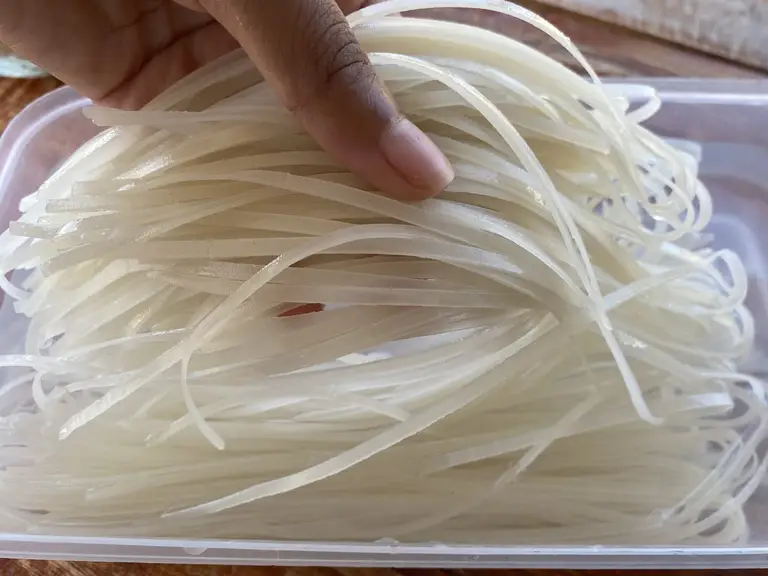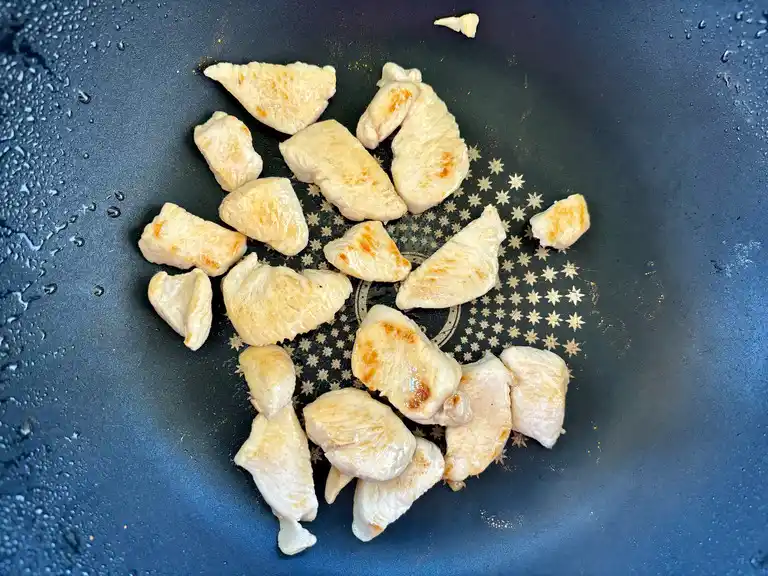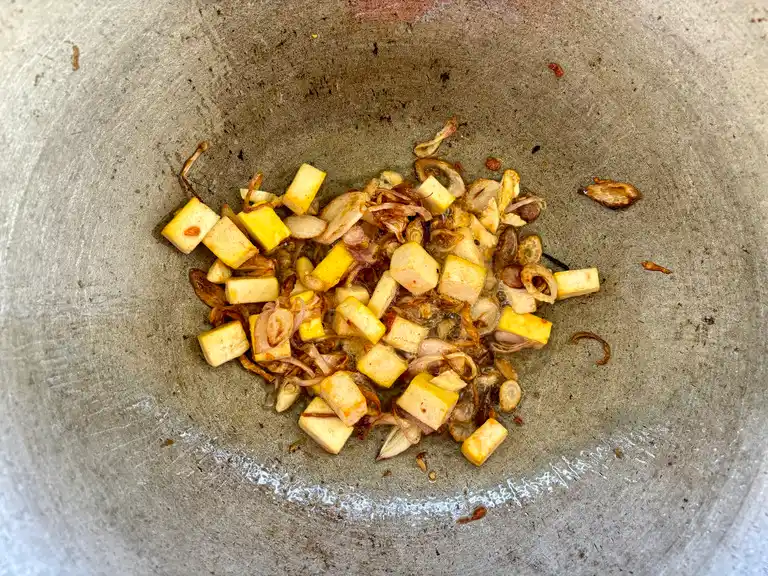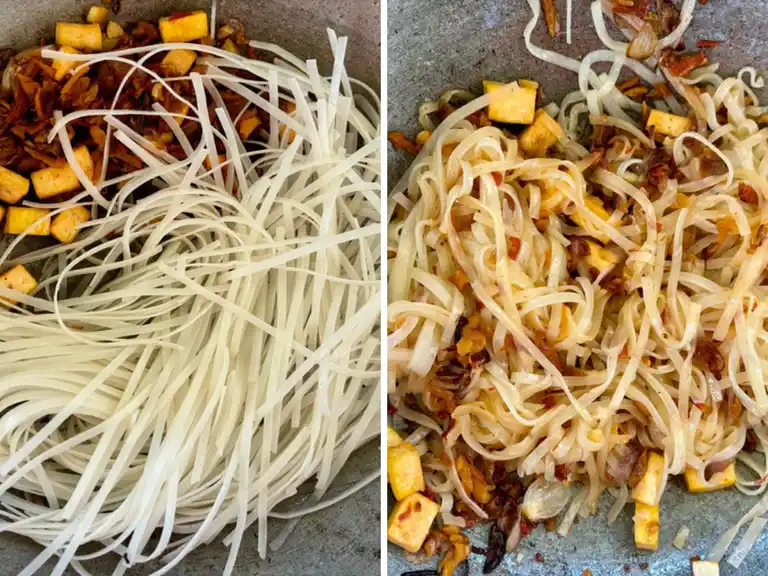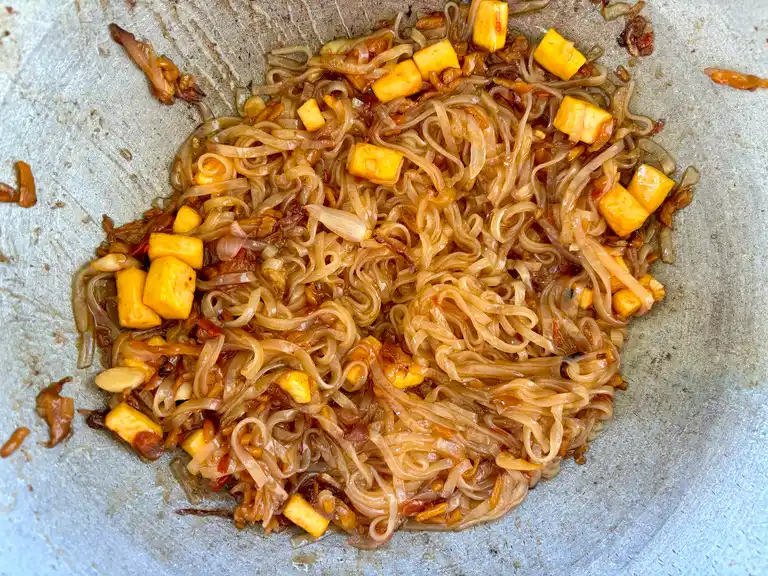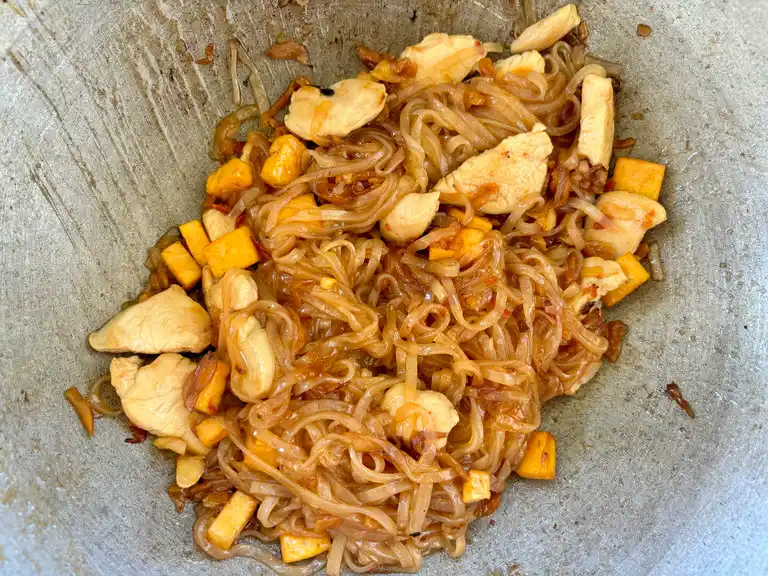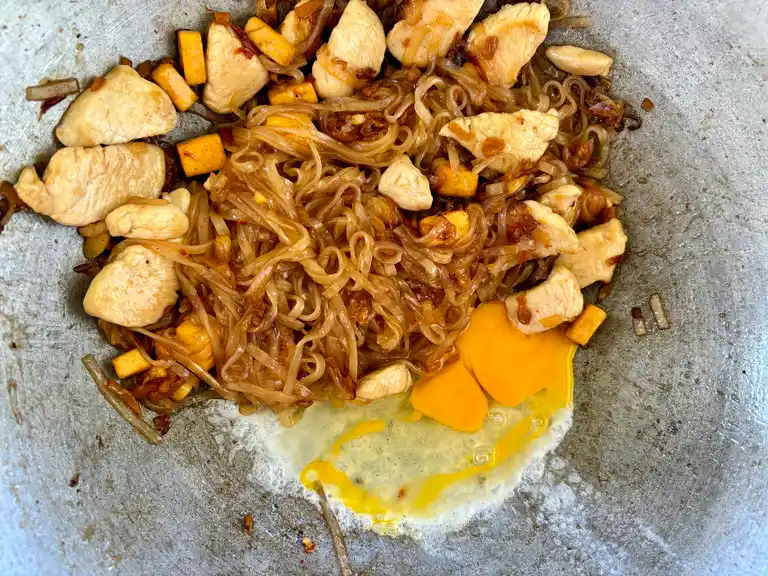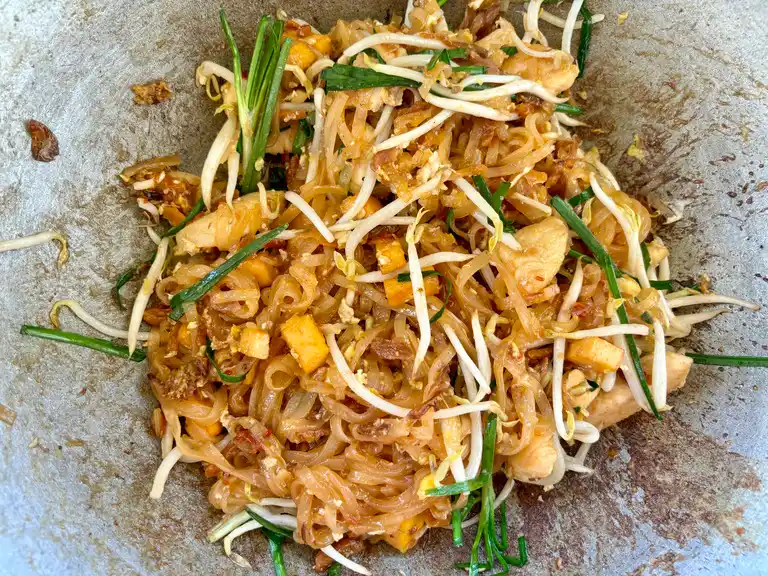As an Amazon Associate, I earn a small commission from qualifying purchases.
Authentic chicken pad Thai recipe – this is the one that’ll outshine your favorite Thai restaurant! Stir-fried noodles tossed in a homemade sauce that perfectly balances salty, sour, and sweet flavors.
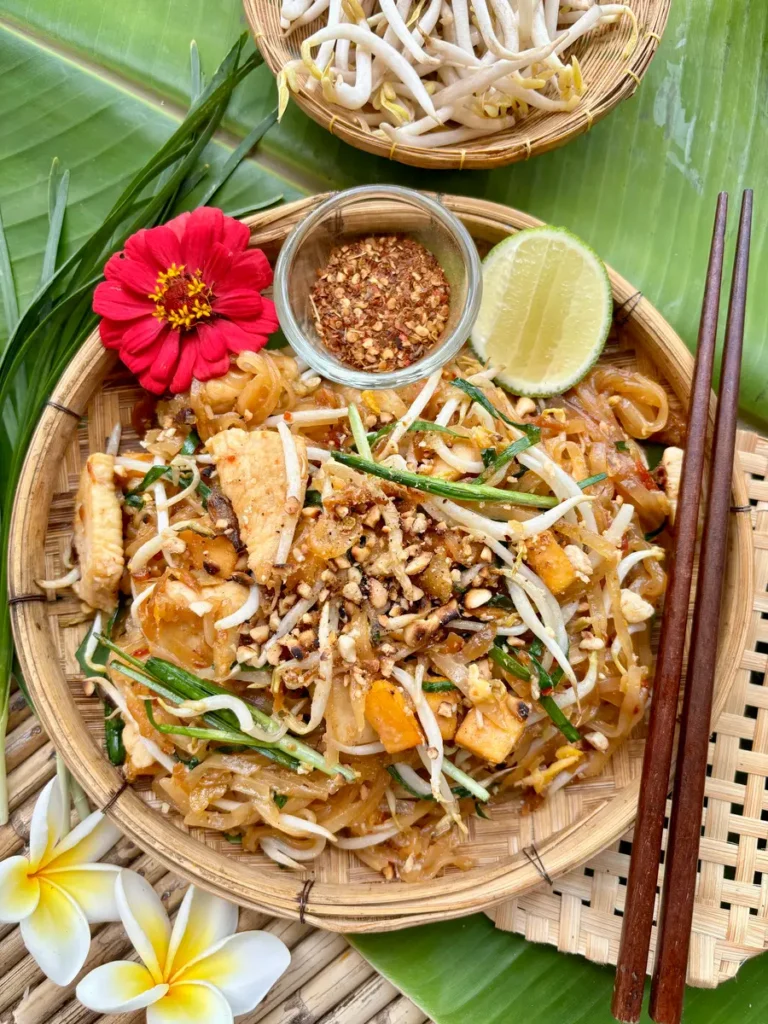
This family recipe is ideal for quick and easy weeknight dinners. Simply make the pad Thai sauce ahead of time and you’ll have dinner ready in less than 30 minutes!
Table of Contents
What is chicken pad Thai
Chicken pad Thai is a classic Thai dish made of stir-fried rice noodles and chicken, tossed in a blend of tamarind, fish sauce, and palm sugar. Often garnished with lime and bean sprouts, this dish offers a balance of sweet, sour, and salty.
Did you know that kua mee is the pad Thai of Lao cuisine? It’s pretty similar but unique in its own way, definitely worth a try after making this!
Authentic chicken pad Thai
Honestly, it’s surprisingly hard to find a truly authentic version, even in some Thai restaurants. What you often get is far from the sweet, tangy, and savory stir-fried noodles that define this classic.
This classic Thai street food is a staple all around the globe, and with it, lots of weird variations exist.

Let’s be real: ketchup and peanut butter in pad Thai? That’s a culinary no-no! Ketchup has no business with authentic Thai chicken noodles.
Some Westernized recipes rely on just vinegar, soy sauce, and sugar. And yes, they’re simple, but they miss the mark on the genuine, authentic flavors.
An authentic chicken pad Thai recipe:
- Has tender noodles with a bite: The noodles are cooked to perfection – tender, yet with a bite – somewhere between soft and al dente.
- Is love at first bite: That traditional blend of fish sauce, tamarind, crisp bean sprouts, and perfectly cooked noodles? It’s what dreams are made of.
- Is balanced: The best pad Thai sauce nails a perfect balance of sweet, salty, and sour, without one flavor overpowering the other.
- Feels light: A portion of these chicken noodles should fill you up perfectly – satisfied without feeling stuffed.
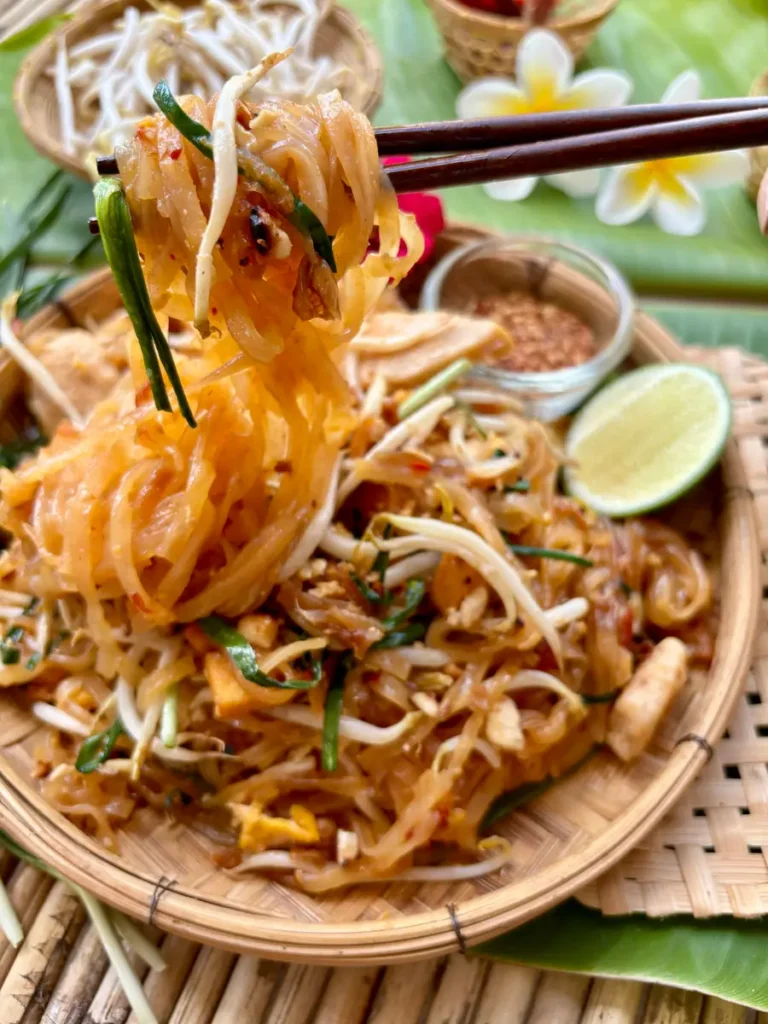
Authentic pad Thai recipe substitutions
Thai food is all about variety. Every region in Thailand, and even each home, has its own special take on flavors and ingredients. You can easily tweak this recipe and make it right just for you:
Vegetables: Feel free to toss in your favorite stir-fry vegetables, it’s not traditional, but you can make this recipe yours. Try bell peppers, carrots, broccoli, snap peas, mushrooms, etc.
Add spice: For those who love spicy pad Thai like pad mee korat, simply add fresh Thai chilies like bird’s eye chilies or sprinkle Thai chili flakes over your finished pad Thai chicken noodles.
Proteins: Not a fan of chicken? No problem! Switch it up with pork, tofu-only, shrimp, or your favorite seafood. Simply adjust the cooking time accordingly. For a version with beef, try my beef pad Thai recipe.
Noodles: No need to stick to the traditional rice noodles. Mix it up with sen yai noodles or glass noodles.
Ingredients
For the exact measurements, please scroll down to the recipe card at the end of this post.
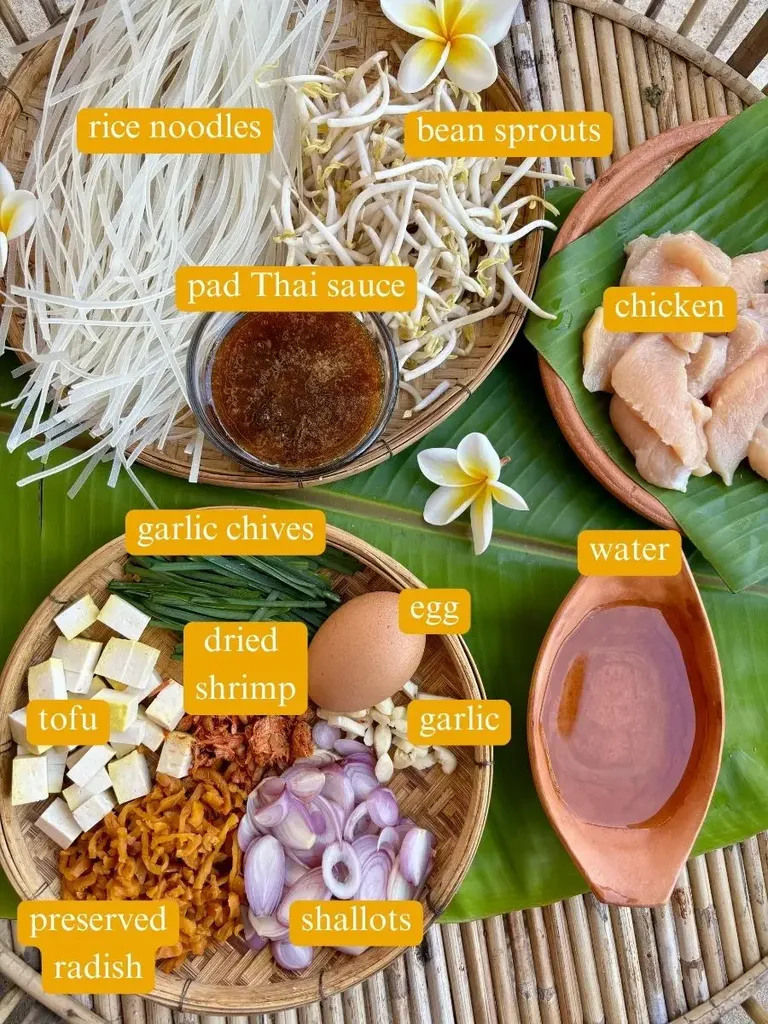
- Pad Thai sauce – The perfect blend of sweet, sour, and salty. Made with palm sugar, tamarind paste, fish sauce, and water.
- Flat dry rice noodles–The noodles should be tender with a slight chew. Dried rice noodles can be found at any Asian grocery stores and different brands are readily available.
- Dried shrimp – A traditional Thai ingredient, dried shrimp adds a depth of umami and seafood flavor.
- Firm tofu – Firm tofu provides a nice tender bite and a unique, subtle flavor. Perfect for vegetarians.
- Chicken–Cut your chicken into thin slices for quick cooking and tenderness. The thinly sliced chicken can easily absorb the pad Thai sauce and blends with the noodles. Use chicken fillets or boneless skinless chicken thighs.
- Sweet preserved radish – Sweet preserved radish adds a subtle tangy-sweet note and crunch to the stir-fried rice noodles.
- Bean sprouts–Bean sprouts, a staple in authentic pad Thai, bring a refreshing crunch and fresh flavors. I like to garnish with fresh bean sprouts just before serving.
- Garlic chives–Garlic chives can be substituted with leek or green onions.
- Shallots – Shallots add a natural sweetness and light onion-like taste without overpowering the other flavors
- Garlic – The fragrant base of many Thai stir-fry dishes, adding a pungent flavor and lots of aroma.
- Egg – Eggs bring a creamy texture and rich flavor that perfectly complements the noodles.
- Oil – Use a neutral oil with high smoke point, like canola oil or vegetable oil.
- Water
Toppings (optional)
- Roasted peanuts –The finishing touch to a great tasting pad Thai are crushed peanuts. Roasting peanuts prior to crushing them will make them even tastier.
- Thai chili flakes – I love eating spicy Thai food, and spicy pad Thai is no exception. With red pepper flakes, you can easily make your noodles spicy.
- Lime – Serve with a lime wedge on the side for adding a tangy note.
Cooking instructions
Step 1: Soak flat rice noodles in water until they are soft but still have a little bit of resistance. Read your package instructions for soaking time.
Step 2: Cook your chicken with 1 tablespoon of oil until it’s done. Remove from pan and set aside.
Step 3: Heat the remaining oil in your wok and fry sliced shallots until golden.
Step 4: Add diced tofu and cook until it has a golden crust. Then, add garlic, dried mini shrimp, and preserved radish, continue to cook for another minute.
Step 5: Move everything to one side of your pan, add the pre-soaked noodles and water in the other half. Then, stir-fry the noodles with water until they’re softened. At this point, mix the whole thing together.
Step 6: Stir in your homemade pad Thai sauce and cook for about a minute, until the noodles are coated with sauce and everything is well mixed.
Step 7: Add your cooked chicken and mix well with the noodles.
Step 8: Move everything to one side of your pan, crack an egg into the other half. Lightly scramble, then thoroughly mix everything.
Step 9: Turn off the heat and stir in your bean sprouts and garlic chives. Serve immediately.
Kitchenware
- Large mixing bowl for soaking the dry rice noodles
- Mortar and pestle for crushing the peanuts
- Cutting board and sharp knife
- Measuring spoons and cups
- Large wok pan with spatula
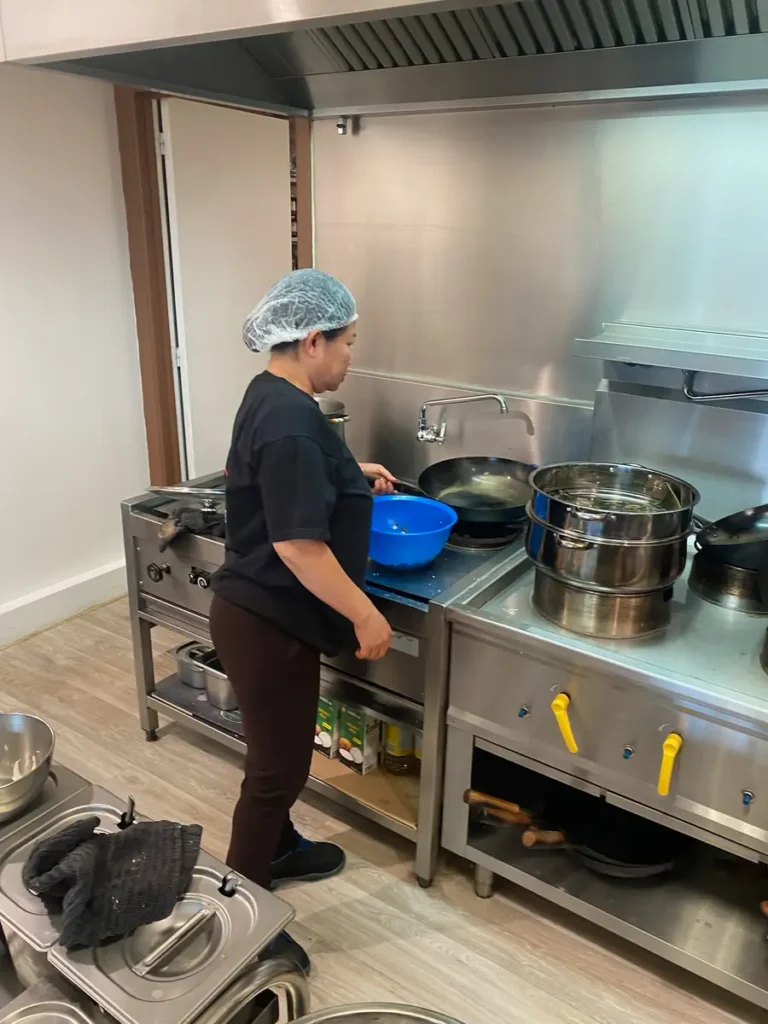
Thai chicken noodles tips
Use my pad Thai sauce recipe: You’ll need one serving of the pad Thai sauce to make enough authentic Thai noodles for two.
Authentic recipe for pad Thai: My mother created this recipe for our former Thai restaurant. It’s easy and packed with genuine flavors.
Don’t overcrowd your pan: Stick to cooking a maximum of 2 portions at a time in a large wok. This ensures every noodle strand gets evenly coated and cooked.
Make the sauce in bulk: Making the sauce in bulk can save you time during those busy weeknights. It freezes perfectly for up to a month.
Vegetarian pad Thai: Use a vegetarian fish sauce alternative to prepare your homemade sauce. Swap chicken for more tofu and omit dried shrimp. The eggs add a rich, creamy texture so if you don’t mind eating eggs I wouldn’t omit them.
Thai noodles serving ideas
Serve your pad Thai hot. Add garnishes like crushed peanuts, white sugar, fresh lime wedges, bean sprouts, and Thai chili flakes.
Serve in an egg wrap
Ever wondered how some Thai restaurants serve pad Thai? In an egg wrap!

Making restaurant-quality chicken pad Thai is easy and totally do-able for every home cook.
Here’s what you need: just 1 egg, a pinch of salt, and a sauce dispenser.

- Beat an egg together with a pinch of salt in a bowl. Pour the egg mixture into a sauce dispenser.
- Squeeze the egg into a non-stick cooking pan or wok pan without using oil. If you don’t have a non-stick pan, use a little bit of oil.
- Once the egg is cooked (this shouldn’t take long), carefully remove it from the pan with a spatula.
- Lay the cooked egg on a flat plate and place it in the fridge for approximately 10 minutes.
- After 10 minutes, take the egg out and lay it in a bowl.
- Place a small portion of pad Thai over the egg.
- Fold the sides of the egg over the pad Thai.
- Put a flat plate on top of the bowl and quickly flip it over.
- Confidently remove the bowl to reveal your dish.
Storing and reheating tips
Let your leftovers cool down until they’re at room temperature. Keep them stored in an airtight container in your fridge for up to three days.
Reheating: Reheat on the stovetop over medium heat until warm. If needed, add a splash of water to the wok. Alternatively, microwave it in a covered dish.
Frequently answered questions
Is pad Thai healthy?
Pad Thai can be a healthy option depending on the recipe and ingredients used. Traditional pad Thai includes protein, vegetables, and carbs. However, it can be high in sodium and sugar.
Is pad Thai gluten-free?
Pad Thai can be gluten-free if it’s not made with soy sauce or other gluten-containing ingredients. However, most recipes call for soy sauces or other gluten-containing seasonings.
Is pad Thai vegetarian?
Pad Thai often contains fish sauce and protein like shrimp or chicken, which is not vegetarian. The ingredients can be modified to turn it into a vegetarian dish.
How many calories are in pad Thai?
A typical serving of pad Thai contains approximately 600 to 700 calories, varying based on ingredients and serving size.
Where to buy pad Thai sauce?
You can find pad Thai sauce at most Asian grocery stores and Asian markets. You can also order it from online retailers.
authentic Thai noodle recipes
- Pad kee mao (drunken noodles)
- Sen mee pad see ew
- Chicken khao soi
- Beef pad see ew
- Yum woon sen
- Pad woon sen
Loved reading this authentic chicken pad thai recipe? Please make my day by dropping a star rating and/or a comment below! Follow me onFacebook,Instagram, andPinterest.

Authentic Chicken Pad Thai Recipe
Author:Praew Cooking Method:Stir-Frying Cuisine:Thai Cuisine Courses:Dinner Recipe Keys: high-protein High Protein Low Carb Low Fat nut-free Nut Free O One Pot
Prep Time15 minCook Time10 minTotal Time25 mins
Servings:2 Calories:641
Description
Authentic chicken pad Thai recipe with the perfect balance of sweet, sour, and salty flavors. You need my homemade pad Thai sauce to make this recipe.
Ingredients
Main
Toppings
Instructions
-
Soak flat rice noodles in water until they are soft but still have a little bit of resistance. Read your package instructions for soaking time.
-
Cook your chicken with 1 tablespoon of oil until it’s done. Remove from pan and set aside.
-
Heat the remaining oil in your wok and fry sliced shallots until golden.
-
Add diced tofu and cook until it has a golden crust. Then, add garlic, dried mini shrimp, and preserved radish, continue to cook for another minute.
-
Move everything to one side of your pan, add the pre-soaked noodles and water in the other half. Then, stir-fry the noodles with water until they’re softened. At this point, mix the whole thing together.
-
Stir in your homemade pad Thai sauce and cook for about a minute, until the noodles are coated with sauce and everything is well mixed.
-
Add your cooked chicken and mix well with the noodles.
-
Move everything to one side of your pan, crack an egg into the other half. Lightly scramble, then thoroughly mix everything.
-
Turn off the heat and stir in your bean sprouts and garlic chives. Serve immediately.
Nutrition Facts
Servings 2
- Amount Per Serving
- Calories 641kcal
- % Daily Value *
- Total Fat 31.8g49%
- Saturated Fat 4.8g24%
- Total Carbohydrate 48.7g17%
- Dietary Fiber 5.6g23%
- Protein 40.1g81%
* Percent Daily Values are based on a 2,000 calorie diet. Your daily value may be higher or lower depending on your calorie needs.
Note
- Use the nutrition card in this recipe as a guideline.
- Chicken: Use chicken fillets or boneless chicken thighs.
- Garlic chives: Can be substituted with leek or green onions.
- Pad Thai sauce: This recipe calls for my homemade pad Thai sauce. The sauce recipe yields just enough to make this recipe for pad Thai.
Keywords: authentic chicken pad Thai recipe, authentic pad Thai recipe, pad thai recipe authentic
